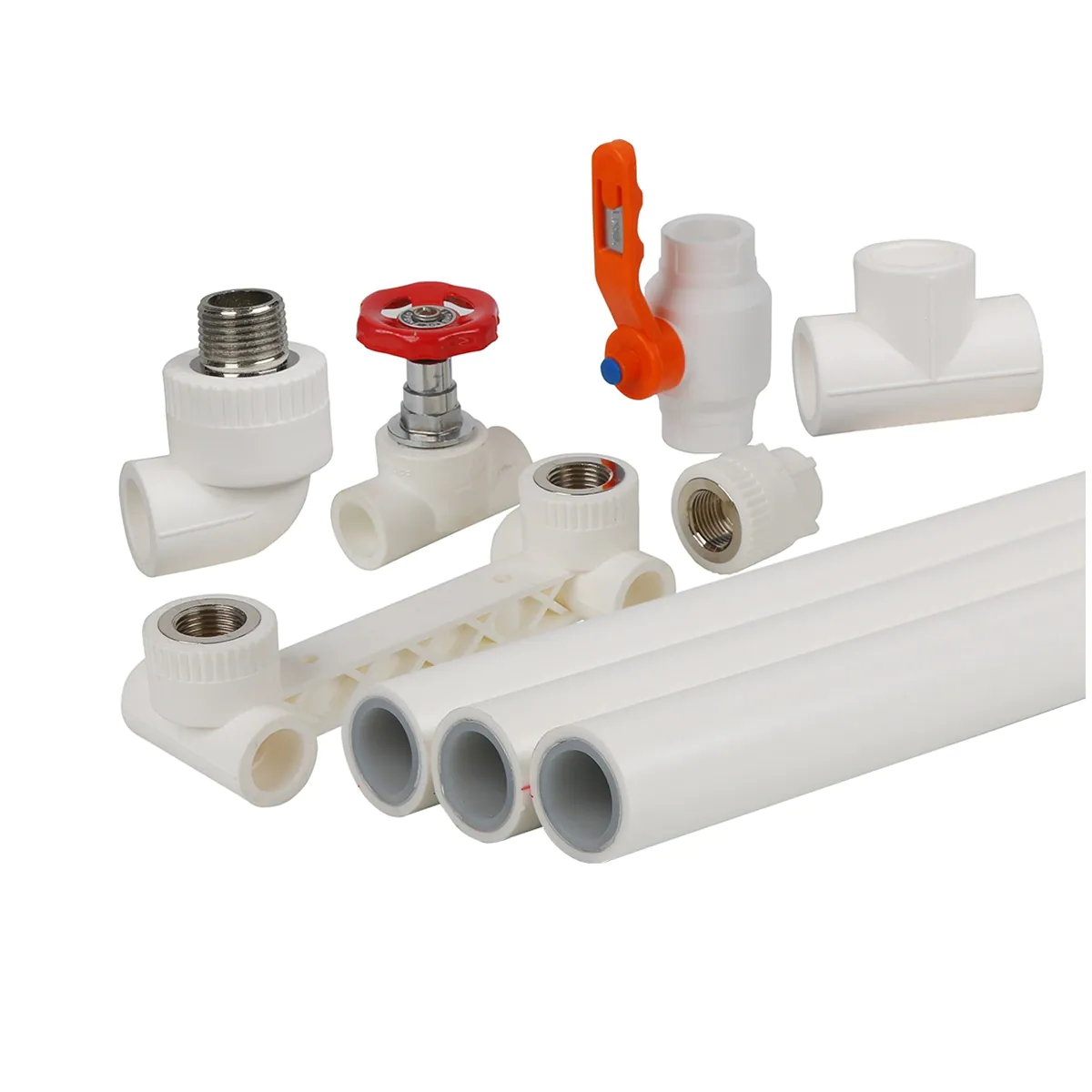Let’s face it, the plumbing aisle can be a jungle of pipes and fittings, leaving DIYers and homeowners scratching their heads. When it comes to drainage and waste lines, two common contenders emerge: ABS and PVC. But which one reigns supreme in your next project? Fear not, plumbing pioneers! This comprehensive guide will unravel the mysteries of ABS vs. PVC pipes, empowering you to make an informed decision.
Feeling lost in the labyrinth of pipes at the hardware store? When it comes to drainage and waste lines, two options dominate the scene: ABS vs. PVC pipe. But which one deserves a starring role in your plumbing project? Don’t sweat it! This guide will untangle the mysteries of these plastic pals, equipping you to make an informed decision.
ABS boasts impressive strength and handles frigid temperatures like a champ, making it ideal for heavy-duty jobs like drain lines and sewer systems. PVC, on the other hand, is the flexibility king, perfect for indoor plumbing and water supply. It’s also budget-friendly and resists chemicals like a boss.
So, which one reigns supreme? It depends! Consider your project’s location, temperature swings, and sun exposure. For example, ABS shines underground, while PVC prefers the shade. Remember, consulting a plumber can help you choose the perfect pipe-mate for your plumbing adventure!
1. Delving into the Depths: Material Matters

ABS (Acrylonitrile Butadiene Styrene): This black beauty boasts impressive strength and impact resistance, making it ideal for heavy-duty applications like drain lines and sewer systems. Additionally, its low thermal conductivity keeps things cool in frigid environments. However, ABS can become brittle under prolonged sunlight exposure, so keep it underground or shaded.
PVC (Polyvinyl Chloride): Available in white or gray, PVC is the go-to choice for indoor plumbing and water supply lines due to its flexibility and affordability. It’s also resistant to chemicals and corrosion, making it a reliable partner for long-term performance. Just remember, PVC’s Achilles’ heel is extreme cold, so bundle it up in colder climates.
Ever feel lost in the plumbing aisle, surrounded by an army of plastic pipes labeled ABS and PVC? Don’t sweat it! Picking the right one is like choosing your plumbing champion, and understanding their material makeup is key.
2. Sizing Up the Situation: Diameter Differences
Both ABS and PVC pipes come in various diameters, measured in inches or Sch (schedule). Sch 40 is the most common for plumbing applications, offering a good balance of strength and affordability. Remember, choosing the correct diameter is crucial for ensuring proper flow and preventing clogs. Consult a plumbing professional or refer to size charts if unsure.
When it comes to plumbing projects, pipe diameter is no small fry. Choosing the right size for your ABS vs. PVC pipe is crucial for smooth flow and avoiding nasty clogs.
Think of it this way: a pipe too narrow is like trying to push a watermelon through a straw – not gonna end well. On the other hand, an oversized pipe can lead to gurgling noises and sluggish drainage.
Both ABS and PVC pipes come in a variety of diameters, usually measured in inches or Sch (schedule). The most common choice for plumbing, Sch 40, offers a sweet spot between strength and affordability. But how do you pick the perfect size for your project?
Don’t worry, plumbing pals! You’re not alone. Consulting a size chart or seeking help from a pro can ensure you snag the right diameter for your ABS or PVC pipe, guaranteeing happy drains and a stress-free plumbing experience. Just remember, sizing up the situation is key to avoiding any drainage disasters!
3. Joining the Ranks: Connection Considerations
ABS: This pipe prefers a one-step cementing process for quick and easy connections. Simply apply the solvent cement and press the two ends together – voila!
PVC: A two-step approach is required for PVC, involving a purple primer for better adhesion followed by solvent cement. While slightly more time-consuming, this method ensures a strong and long-lasting bond.
When it comes to connecting your pipes, both ABS and PVC have their own party tricks. ABS throws a one-step cement bash, where you simply apply the magic glue and press the pipes together – instant connection! Talk about fast and simple. PVC, on the other hand, prefers a two-step process.
First, you prime the pipes with a purple potion for better bonding, then apply the cement – like prepping for a fancy paint job. While it takes a tad longer, it ensures a strong and lasting bond, just like a well-prepped party is bound to be memorable. So, which joining style suits your project? The one-step convenience of ABS or the two-step security of PVC? Choose wisely, plumbing pal, and your pipes will thank you for the epic party!
4. Temperature Talk: Hot and Cold Realities

ABS: This champ thrives in cold environments, handling temperatures as low as -40°F (-40°C). Its low thermal conductivity prevents freezing in colder climates.
PVC: While not as cold-resistant as ABS, PVC can handle temperatures down to 20°F (-6°C). However, proper insulation is crucial in colder regions to prevent damage.
When it comes to temperature, ABS and PVC pipes duke it out in different arenas. ABS emerges as the cold warrior, handling frosty temperatures down to a staggering -40°F (-40°C). Its low thermal conductivity keeps things cool, making it ideal for underground drain lines and sewer systems in chilly climates. Think of it as the pipe that laughs in the face of Mr. Freeze.
However, PVC prefers warmer waters, holding its own up to 140°F (60°C). This makes it a popular choice for hot water lines within your home. While not as cool as ABS, it won’t crack under the pressure of your morning shower. So, who wins the temperature battle? It depends on where the fight takes place – ABS in the arctic, PVC in the tropics.
5. Sun’s Out, Buns Out… Not Pipes!
ABS: This sun-sensitive fella doesn’t do well with prolonged exposure to ultraviolet (UV) rays, which can cause warping and brittleness. Keep it underground or shielded from the sun.
PVC: While not entirely UV-resistant, PVC fares better than ABS in sunlight. However, extended exposure can still lead to degradation, so consider shading or using different materials for above-ground applications.
Picture this: a sunny day, barbecue sizzling, tunes cranked… and your ABS pipes basking in all that glory. Not ideal! Unlike your beach bod, ABS (Acrylonitrile Butadiene Styrene) pipes don’t tan well. Those harmful UV rays can make them brittle and prone to warping, turning your drainage dreams into leaky nightmares.
So, while PVC pipes can handle some sunshine, ABS prefers to stay cool and shaded, underground or covered up. Think of it like choosing the right outfit for the occasion – ABS for the shade, PVC for a touch of sun. Remember, happy pipes mean happy plumbing, and that means more time for fun in the sun (responsibly, of course!).
6. Chemical Compatibility: Avoiding Nasty Reactions

Both ABS and PVC offer decent chemical resistance, making them suitable for most household drainage and water supply applications. However, always consult the manufacturer’s specifications for specific chemicals, as some may cause damage.
So, you’ve picked your champion pipe (woohoo!), but hold on a sec, plumbing partner. What about the chemicals it’ll encounter? Both ABS and PVC are pretty tough cookies, but they don’t like everything on the periodic table. While they handle most household stuff like champs, some chemicals can cause them to crack, soften, or even leak – yikes!
Here’s the deal:
- ABS: This dude is generally good with acids, bases, and alcohols, but steer clear of ketones, esters, and some hydrocarbons. They can make him brittle and grumpy.
- PVC: This versatile fella handles most alkalis, salts, and even some bleaches. However, strong acids and organic solvents like paint thinner are a big no-no. They can melt his cool composure.
Remember: Always check the manufacturer’s specs for specific chemicals, and when in doubt, play it safe! Don’t let a surprise chemical reaction turn your plumbing project into a fizzy, leaky mess.
So, choose your pipe wisely, consider the chemicals it might face, and your plumbing journey will be smooth sailing!
7. Cost Considerations: Balancing Budget and Needs
ABS: Generally, ABS is slightly more expensive than PVC. However, its increased strength and cold resistance may justify the cost for specific applications.
PVC: The budget-friendly option, PVC is a good choice for most indoor plumbing needs. Remember, the cheapest option isn’t always the best – consider long-term performance and suitability for your project.
Alright, let’s talk turkey – your wallet wants to know, which pipe reigns supreme in the cost arena? Generally, PVC holds the budget crown, being slightly cheaper than its ABS counterpart. But before you do a victory dance, consider this: ABS might pack a stronger punch for your buck. Its impressive durability and cold resistance translate to potentially fewer repairs and replacements down the line, saving you money in the long run.
So, while PVC might seem like the immediate steal, ABS could be the more strategic investment depending on your project’s demands. Ultimately, the champion of cost depends on your specific needs and budget priorities. Weigh the upfront price against potential future expenses for a truly winning decision!
8. The Final Verdict: Choosing Your Champion

So, you’ve weighed the contenders in the ABS vs. PVC pipe ring. Now, it’s time to declare a champion for your project! Remember, there’s no one-size-fits-all answer. Consider these key factors:
Location: Is it an underground warrior battling frigid temperatures (ABS might be your champ)? Or, an indoor maestro handling water supply (PVC could take the crown)?
Temperature extremes: Does your project face scorching heat or bone-chilling cold? ABS handles chills better, while PVC tolerates moderate heat.
Sun exposure: Is your pipe a sunbather? PVC has slightly better sun resistance, but both need shade for long-term durability.
Budget: Is affordability your main concern? PVC reigns supreme on price, but ABS might be worth the splurge for specific needs.
Local rules: Don’t forget to check your local building codes! They might have preferences for ABS vs. PVC in your area.
By keeping these factors in mind, you’ll choose the pipe that best suits your project’s needs and emerges victorious in your ABS vs. PVC battle! Remember, consulting a plumbing pro can always offer valuable insights for a truly winning decision.
The battle between ABS and PVC ultimately boils down to your specific project requirements. Consider these factors:
- Application: Where will the pipe be used (indoors, outdoors, underground)?
- Temperature extremes: Will the pipe be exposed to extreme cold or heat?
- Sunlight exposure: Will the pipe be directly exposed to sunlight?
- Budget: What is your budget for the project?
- Local building codes: Are there any restrictions on using ABS or PVC in your area?
By carefully weighing these factors, you’ll be well-equipped to choose the champion pipe for your plumbing project. Remember, consulting a qualified plumber for professional advice is always a wise investment.

